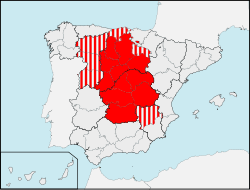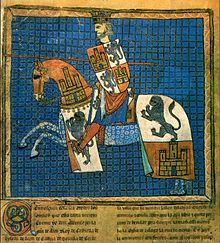

A former kingdom, Castile (Spanish: Castilla, pronounced [kasˈtiʎa]) gradually merged with its neighbors to become the Crown of Castile and later the Kingdom of Spain with the Crown of Aragon and the Kingdom of Navarre. In modern-day Spain, it is usually considered to comprise a part of the autonomous community of Castilla y León in the north-west, and Castilla-La Mancha and Madrid in the center and south of the country, including sometimes Cantabria and La Rioja as well, for historical reasons. However, there are different versions about the exact boundaries of Castile, and since it lacks an official recognition, it has no official borders. It is traditionally divided between Old Castile, which is the eastern half of Castilla y Leon and New Castile, which is Castilla-La Mancha and the Community of Madrid. Modern Spanish monarchs are numbered according to the system of Castile.
Castile's name is thought to mean land or region of castles, in reference to the castles built in the area to consolidate the Christian Reconquest from the Moors. The Spanish word for castle is actually castillo.
Contents[hide] |
[edit] History
Historically, the Castilian Kingdom and people were considered to be the main architects of the Spanish State by a process of expansion to the South against the Muslims and of marriages, wars, assimilation, and annexation of their smaller Eastern and Western neighbours. From the advent of the Bourbon Monarchy following the War of the Spanish Succession until the arrival of parliamentary democracy in 1977, the Castilian language was the only one with official status in the Spanish State.
Originally an eastern county of the kingdom of León, in the 11th century Castile became an independent realm with its capital at Burgos and later Valladolid, and the leading force in the northern Christian states' 800-year Reconquista ("reconquest") of central and southern Spain from the Muslim rulers who had dominated most of the peninsula since the early 8th century.
The capture of Toledo in 1085 added New Castile to the crown's territories, and the battle of Las Navas de Tolosa (1212) heralded the Muslim loss of most of southern Spain. León was finally reunited with Castile in 1230, and the following decades saw the capture of Córdoba (1236), Murcia (1243) and Seville (1248). By the Treaty of Alcaçovas with Portugal on March 6, 1460, the ownership of the Canary Islands was transferred to Castile.
The dynastic union of Castile and Aragon in 1469, when Ferdinand II of Aragon wed Isabella I of Castile, would eventually lead to the formal creation of Spain as a single entity in 1516 when their grandson Charles V assumed both thrones. See List of Spanish monarchs and Kings of Spain family tree.
Today many people[who?] consider that the territory traditionally regarded as Castile corresponds to the Spanish autonomous communities of Cantabria, Castile and Leon, Castile-La Mancha, Madrid and La Rioja although this territory was conquered by Castile's Crown and separated of the Navarrese Kingdom, as the Basque Country was. Other territories in the former Crown of Castile are left out for different reasons. In fact, the territory of the Castilian Crown actually comprised all other autonomous communities within Spain with the exception of Aragon, Balearic Islands, Valencia and Catalonia, which all belonged to the late Crown of Aragon, and Navarre, heir of the older Kingdom of the same name.
-
Kingdoms of the Crown of Castile in 1400
-
Old Castile and New Castile from 1833 until the reorganisation of regions into comunidades autonomas after Franco's death. Some Castillian nationalists want a comunidad autonoma based on these 1833 administrative regions.
-
The Castilian comunidades autonomas today. Cantabria and La Rioja have seperated and are autonomias in their own right. However, the Leonese Country was joint to Old Castile to become Castilla y Leon. They are now three regions, two of which contain the name Castile. Madrid seperated from New Castile (which became Castilla-La Mancha).
[edit] Language
The language of Castile emerged as the primary language of Spain—known to many of its speakers as castellano and in English sometimes as Castilian, but generally as Spanish. See Names given to the Spanish language.
[edit] Castilian identity and cultural expansion

(Latin was de jure around Iberian peninsula in that time).
Castilians are defined as a community with a shared culture and history. Their origin is, as well as most of other parts of the Spain, a heterogeneous mixture of Celtiberian, Roman, Basque and Germanic peoples (see also Spanish people). Thus, it is not correct to establish a strict common origin, but a common cultural identity. Over time, most Castilians have mixed with other Spaniards due to their past political dominance, and present-day cultural dominance. Castilians and their cultural influence spread throughout the entire plateau of central Spain during the Reconquista, carried out principally by the Kingdom of Toledo which was renamed New Castile. Castilian ethnicity is the product of the conquest, by a small kingdom in northern Spain, of vast tracts of sparsely populated lands (the central "mesetas"). These lands were populated, during the reconquest, by peoples from all over the peninsula (even from southern Spain (see exile of Mozarabes from Al Andalus and even the dispersal of Moriscos from Granada in the 16th century).
The Castilian language (i.e. Spanish) became the main language in Spain; it is often referred to as "Castilian" in both Spain and Latin America. At present, Castilians are known as the inhabitants of those regions of Spain where there is no regional identity which conflicts with that of "Castilian". The Castilian regions roughly coincide with the plateaus of north-central Spain, historically sparsely populated highlands.
Castilian identity is not completely unambiguous: since Castilian nationalism was the first to have been stopped by the Spanish Crown during the revolt and war of the Castilian War of the Communities against the Spanish Monarchy, between 1520 and 1521, a strong sense of identity cannot be found in Castilians and there are differences about what can be considered Castile.
Castilian identity is thus excluded from the historical nationalities of Spain such as Catalonia, Galicia and the Basque regions, but also other regions which due to historical reasons have their own identity and culture, such as the Andalusian region, Asturias, Aragon or the Canary Islands. Both Andalusia and the Canary Islands experienced an early Castilian colonisation and subsequent immigration, but the survival and absorption of (or by) local populations allowed for cultural traits particular to those regions. Certain regions are not considered Castilian, such as Valencia and the Balearic Islands because historically they belong to the Crown of Aragon and because their local languages are Catalan dialects. Galicians are not considered to be Castilian, although their region was annexed by the Crown of Castile. Their language, Galician, is akin to Portuguese, and they possess a local culture and identity. Navarre, a historical kingdom in its own right, has a culture that is mainly Basque in the north and closer to the rest of Spain, especially to La Rioja and Aragon, in the south. Extremadura, a region in western Spain, is usually not considered to be Castilian; it has many links to neighbouring Andalusia. Murcia has always been a region of its own. The Leonese region was a seperate region before democracy in the 1970s, and had its own language, Leonese, which is moribund. However, Castilla y Leon had the Spanish word 'y' inserted as the Leonese do not consider Leon to be in Castile (the north half) but joint with it in this comunidad autonoma. Some Leonese want Castilla y Leon to be dissolved and become a comunidad autonoma in its own right. Cantabria used to be considered a part of Old Castile, but they have their own identity and had acheived independence from Castile in the 1970s and are now a comunidad autonoma in their own right. Madrid had been in New Castile until the 1970s and has traditionally been considered Castilian. However, its status as the capital of Spain, meant that it gained its own comunidad autonoma. Also, its people are not all Castilian as there have been immigration from other regions in Spain and indeed the world. In terms of cultural identity, there is a divide and controversy. Older Madrid people as well as Castilians nationalist in the region consider their city to be in Castile (cultural identity). Younger Madrid people, look at the modern reality of the administration, and do not consider it to be in Castile, as there is no reference to it in the name or the symbols of the comunidad autonoma. However, the folk culture in the Madrid region is Castilian, even though the city itself has its own folklore, the chotis. As for La Mancha, they are still in Castile as their comunidad autonoma is called Castilla-La Mancha. However, their cultural identity focuses on the La Mancha rather than on the Castilla. They have their own identity even though they are recognised as fully Castilian, for example, they had no language of their own, unlike, Leon.
(COPY OF WIKIPEDIA)






No comments:
Post a Comment